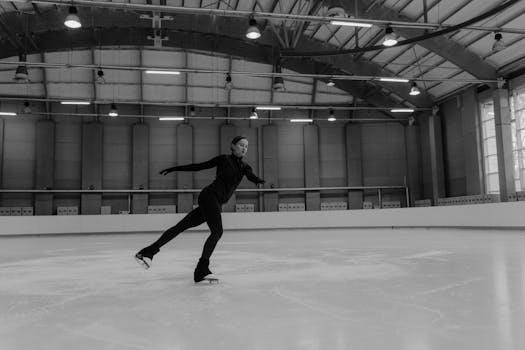Understanding ITB Syndrome
Iliotibial band syndrome‚ often called ITBS or runner’s knee‚ causes pain and inflammation along the outer thigh and knee. It’s due to tightness or inflammation in the iliotibial band‚ a thick fascia band. This condition affects runners‚ weightlifters‚ hikers‚ and cyclists. Improper mechanics can contribute to this pain.
What is the IT Band?
The Iliotibial Band‚ or IT band‚ is a thick‚ fibrous band of fascia‚ a type of connective tissue‚ that extends along the outside of your thigh. It originates at the iliac crest on the hip bone and runs down the outer thigh‚ crossing both the hip and knee joints‚ before attaching to the tibia‚ the shin bone‚ just below the knee. This band is not a muscle‚ but rather a dense connective tissue that plays a crucial role in stabilizing the pelvis and assisting with hip extension and rotation. It acts like a tendon‚ connecting muscles to bone‚ helping to facilitate movement. The IT band helps stabilize the hip and knee joints during movement‚ especially during activities that involve repetitive motions. It is not designed to stretch significantly but can become tight or inflamed due to overuse or biomechanical issues‚ leading to pain and discomfort.
Causes of ITB Syndrome
ITB syndrome primarily arises from overuse or improper biomechanics. Repetitive movements‚ such as those in running‚ cycling‚ or hiking‚ can cause friction and irritation where the IT band crosses the bony prominence of the femur at the knee. This repetitive rubbing leads to inflammation and pain. Tightness in the IT band or hip abductor muscles is a significant contributing factor‚ restricting proper movement. Mechanical imbalances‚ like poor pelvic alignment or low back issues‚ can cause the band to stretch excessively‚ increasing friction. Dramatic increases in training intensity or volume can also overwhelm the IT band‚ leading to inflammation. Furthermore‚ factors like muscle weakness‚ particularly in the hips and glutes‚ and poor flexibility can predispose individuals to ITBS. An uneven gait or leg length discrepancy can also contribute to the problem. Overpronation of the foot can also lead to an increased risk of developing the syndrome.

Effective Exercises and Stretches
Addressing ITB syndrome involves targeted exercises and stretches. These focus on improving flexibility and strengthening muscles surrounding the IT band. Specific stretches indirectly target the IT band by loosening related muscles. Strengthening exercises for the hips and glutes are also crucial.

IT Band Stretches (Indirect)
It’s crucial to understand that the IT band itself cannot be directly stretched due to its dense‚ fibrous nature. Instead‚ effective strategies involve indirectly addressing the muscles that attach to and influence the IT band. These indirect stretches aim to alleviate tension and improve flexibility in surrounding areas‚ ultimately reducing IT band tightness and associated pain. Focus on stretching the tensor fascia latae (TFL) muscle‚ located at the hip‚ as it directly connects to the IT band. Hip flexor stretches are also beneficial‚ as tightness in this area can contribute to ITB issues. Additionally‚ incorporate glute stretches‚ as these muscles play a vital role in pelvic stability‚ which impacts the IT band. These stretches should be held for extended periods‚ typically ranging from one to six minutes‚ and repeated several times for optimal results. Remember that consistency in performing these stretches is key to managing and preventing ITB syndrome.
Hip Strengthening Exercises
Strengthening the hip muscles is paramount in managing and preventing ITB syndrome. Weak hip abductors and external rotators often contribute to poor biomechanics‚ placing undue stress on the IT band. Effective hip strengthening exercises include side-lying leg raises‚ which directly target the abductors. Clamshell exercises‚ performed with a resistance band around the knees‚ also enhance hip stability and strength. Single-leg squats and bridges are beneficial for improving overall hip and glute strength while also promoting balance and control. These exercises should be performed with proper form and a controlled range of motion‚ gradually increasing the repetitions or resistance as strength improves. Additionally‚ incorporating lateral walks with a resistance band around the ankles can engage the hip abductors effectively. Consistent practice of these exercises can help to stabilize the pelvis‚ reduce stress on the IT band‚ and promote healthy joint function.
Glute Strengthening Exercises
Strengthening the gluteal muscles‚ including the gluteus maximus‚ medius‚ and minimus‚ is crucial for managing and preventing ITB syndrome. Strong glutes stabilize the pelvis‚ reducing stress on the IT band. Effective exercises include glute bridges‚ which can be progressed by adding a resistance band around the thighs or performing them on one leg. Donkey kicks and fire hydrants are excellent for targeting the gluteus medius and minimus. Hip thrusts‚ done with a barbell or resistance band‚ are a powerful exercise for building overall glute strength. Incorporating single-leg deadlifts helps improve balance and stability while engaging the glutes. Side-lying hip abductions also contribute to strengthening the gluteus medius. It’s important to perform these exercises with correct form and controlled movements‚ gradually increasing the difficulty as strength improves. Consistent glute strengthening helps to improve hip function and reduce the likelihood of ITB issues.

Treatment and Management
Effective management of ITB syndrome typically involves conservative treatments like rest‚ physical therapy‚ and targeted exercises. In severe cases‚ corticosteroid injections or surgery might be considered. Consistent adherence to a treatment plan is vital for pain relief and long-term recovery;
Conservative Treatments
Conservative treatments are usually the first approach for managing ITB syndrome and often prove highly effective. These methods focus on reducing inflammation and pain‚ and restoring normal function. Rest is crucial; avoiding activities that aggravate the condition allows the IT band to heal. Physical therapy plays a vital role‚ employing targeted exercises and stretches to improve flexibility and strength. Anti-inflammatory medications‚ such as ibuprofen or naproxen‚ can be used to alleviate pain and inflammation. Additionally‚ foam rolling the muscles around the IT band‚ like the glutes and TFL‚ can help release tension. Modifying training routines and ensuring proper footwear can also aid in recovery. These strategies aim to address the root cause of ITB syndrome‚ rather than just treating the symptoms‚ making them a cornerstone of successful management. Consistency with these treatments is essential for long-term relief. The goal is to reduce the friction and irritation caused by the tight IT band‚ allowing you to return to your activities pain-free.

Physical Therapy for ITBS
Physical therapy is a cornerstone in treating IT band syndrome‚ offering a structured approach to recovery. A physical therapist will assess your range of motion‚ strength‚ and movement patterns to create a personalized plan. This plan often includes specific exercises and stretches‚ focusing on the muscles surrounding the IT band‚ like the glutes‚ hip flexors‚ and tensor fascia latae (TFL). These exercises aim to correct muscle imbalances and improve overall biomechanics. They will also teach you proper stretching techniques‚ focusing on muscles that connect to the IT band rather than the band itself. Manual therapy‚ like soft tissue mobilization‚ can help reduce tension and improve tissue flexibility. Furthermore‚ a physical therapist can guide you on how to gradually return to your activities without re-injuring yourself. They will also provide you with a home exercise program to continue your progress. Physical therapy ensures a comprehensive approach to healing and preventing future IT band issues.
When to Seek Professional Help
Knowing when to seek professional help for IT band issues is crucial for effective management and preventing long-term problems. If your pain persists despite rest‚ stretching‚ and home exercises‚ it’s time to consult a healthcare professional. Experiencing sharp‚ burning pain on the outside of your knee‚ especially after activity‚ warrants an evaluation. If the pain starts earlier during exercise or continues even after you stop‚ professional intervention is needed. Limited range of motion or difficulty with everyday activities‚ like climbing stairs‚ are also indicators. A physical therapist can assess your condition and design a tailored treatment plan. They can identify underlying issues and provide specialized exercises‚ stretches‚ and manual techniques. If your symptoms are severe or not improving with conservative measures‚ a doctor can evaluate the need for further treatment‚ such as injections. Seeking professional help ensures an accurate diagnosis and a more effective recovery.